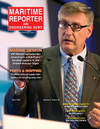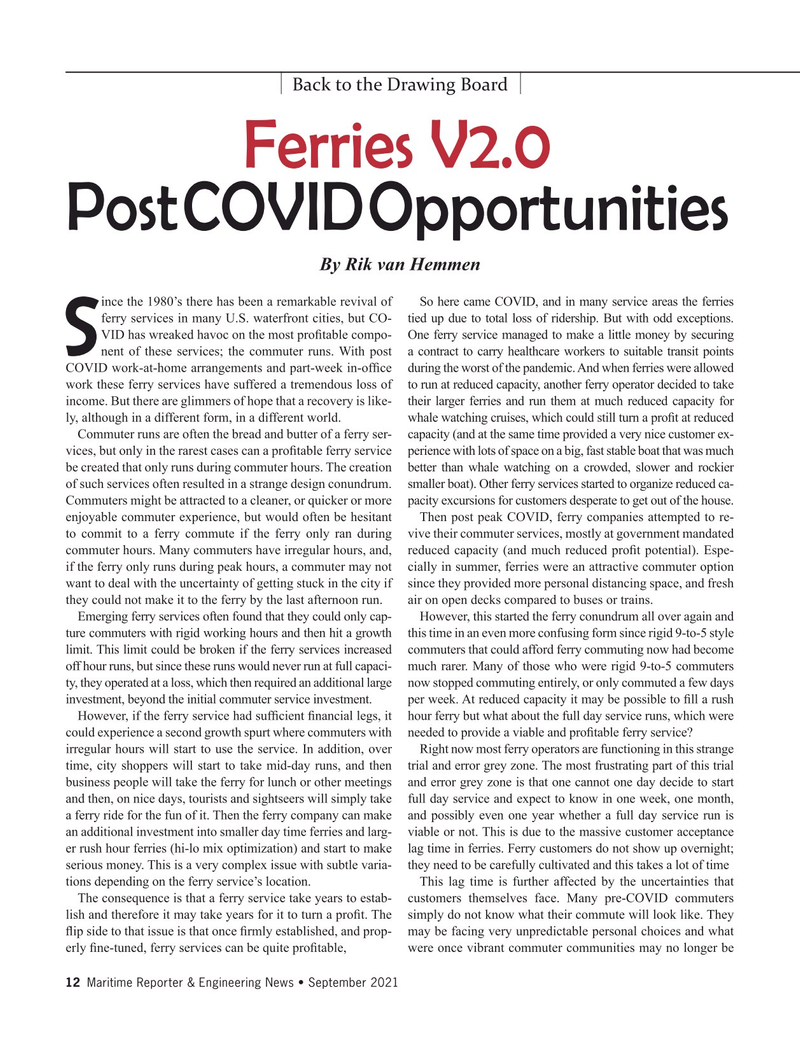
Page 12: of Maritime Reporter Magazine (September 2021)
The Marine Design Edition
Read this page in Pdf, Flash or Html5 edition of September 2021 Maritime Reporter Magazine
Back to the Drawing Board
Ferries V2.0
Post COVID Opportunities
By Rik van Hemmen ince the 1980’s there has been a remarkable revival of So here came COVID, and in many service areas the ferries ferry services in many U.S. waterfront cities, but CO- tied up due to total loss of ridership. But with odd exceptions.
VID has wreaked havoc on the most pro? table compo- One ferry service managed to make a little money by securing
Snent of these services; the commuter runs. With post a contract to carry healthcare workers to suitable transit points
COVID work-at-home arrangements and part-week in-of? ce during the worst of the pandemic. And when ferries were allowed work these ferry services have suffered a tremendous loss of to run at reduced capacity, another ferry operator decided to take income. But there are glimmers of hope that a recovery is like- their larger ferries and run them at much reduced capacity for ly, although in a different form, in a different world. whale watching cruises, which could still turn a pro? t at reduced
Commuter runs are often the bread and butter of a ferry ser- capacity (and at the same time provided a very nice customer ex- vices, but only in the rarest cases can a pro? table ferry service perience with lots of space on a big, fast stable boat that was much be created that only runs during commuter hours. The creation better than whale watching on a crowded, slower and rockier of such services often resulted in a strange design conundrum. smaller boat). Other ferry services started to organize reduced ca-
Commuters might be attracted to a cleaner, or quicker or more pacity excursions for customers desperate to get out of the house.
enjoyable commuter experience, but would often be hesitant Then post peak COVID, ferry companies attempted to re- to commit to a ferry commute if the ferry only ran during vive their commuter services, mostly at government mandated commuter hours. Many commuters have irregular hours, and, reduced capacity (and much reduced pro? t potential). Espe- if the ferry only runs during peak hours, a commuter may not cially in summer, ferries were an attractive commuter option want to deal with the uncertainty of getting stuck in the city if since they provided more personal distancing space, and fresh they could not make it to the ferry by the last afternoon run. air on open decks compared to buses or trains.
Emerging ferry services often found that they could only cap- However, this started the ferry conundrum all over again and ture commuters with rigid working hours and then hit a growth this time in an even more confusing form since rigid 9-to-5 style limit. This limit could be broken if the ferry services increased commuters that could afford ferry commuting now had become off hour runs, but since these runs would never run at full capaci- much rarer. Many of those who were rigid 9-to-5 commuters ty, they operated at a loss, which then required an additional large now stopped commuting entirely, or only commuted a few days investment, beyond the initial commuter service investment. per week. At reduced capacity it may be possible to ? ll a rush
However, if the ferry service had suf? cient ? nancial legs, it hour ferry but what about the full day service runs, which were could experience a second growth spurt where commuters with needed to provide a viable and pro? table ferry service?
irregular hours will start to use the service. In addition, over Right now most ferry operators are functioning in this strange time, city shoppers will start to take mid-day runs, and then trial and error grey zone. The most frustrating part of this trial business people will take the ferry for lunch or other meetings and error grey zone is that one cannot one day decide to start and then, on nice days, tourists and sightseers will simply take full day service and expect to know in one week, one month, a ferry ride for the fun of it. Then the ferry company can make and possibly even one year whether a full day service run is an additional investment into smaller day time ferries and larg- viable or not. This is due to the massive customer acceptance er rush hour ferries (hi-lo mix optimization) and start to make lag time in ferries. Ferry customers do not show up overnight; serious money. This is a very complex issue with subtle varia- they need to be carefully cultivated and this takes a lot of time tions depending on the ferry service’s location. This lag time is further affected by the uncertainties that
The consequence is that a ferry service take years to estab- customers themselves face. Many pre-COVID commuters lish and therefore it may take years for it to turn a pro? t. The simply do not know what their commute will look like. They ? ip side to that issue is that once ? rmly established, and prop- may be facing very unpredictable personal choices and what erly ? ne-tuned, ferry services can be quite pro? table, were once vibrant commuter communities may no longer be 12 Maritime Reporter & Engineering News • September 2021
MR #9 (1-17).indd 12 9/7/2021 9:23:10 AM

 11
11

 13
13
